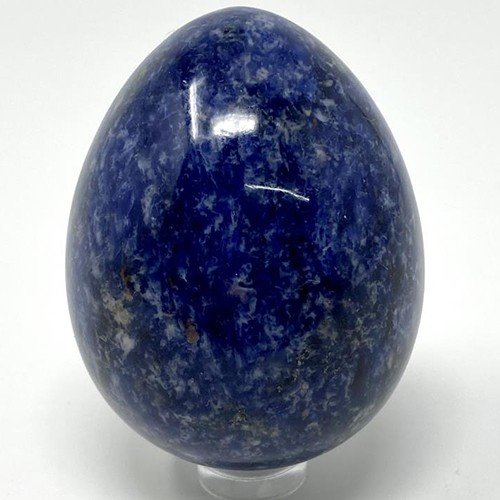Sodalite Stone
Is Sodalite the Same Gemstone as Lapis Lazuli?
The gemstone know as sodalite belongs to the sodalite mineral group, which includes haüyne, lazurite, and nosean. All typically blue, these minerals are actually found in lapis lazuli. That is, lapis is a rock made up principally of these materials. However, sodalite and haüyne can also occur separately and even have their own varieties.
What is Hackmanite?
Hackmanite, a sulfur-rich variety of sodalite, shows tenebrescence. When first mined, stones from Canada and Greenland can range from pink to violet. In sunlight, however, they fade to grayish white or white. On the other hand, hackmanites from Afghanistan and Myanmar start white but turn pink or violet in sunlight. Darkness will reverse these effects.
Are There Lab-Created Sodalites?
Laboratories have synthesized sodalites, but the natural gems aren't rare, so no real market for them exists. However, sodalites, either natural or synthetic, can simulate other blue gems, such as lapis lazuli. Since lapis lazuli is a better known material, it's more likely you'll encounter sodalites offered as lapis gems, either in error or a deliberate effort to mislead.
Sodalite Properties and Identification
Although both sodalite and lapis can have inclusions of calcite, you can distinguish them by sodalite's lack of pyrite inclusions.
Other popular blue gem materials, like azurite, lazulite (no relation to lazurite), and turquoise, typically show different shades of blue than sodalite. However, if the colors seem close, these stones react differently to ultraviolet testing.
Hackmanite from Dungannon Township, Ontario, Canada will luminesce bright pale pink in shortwave (SW) ultraviolet light. In longwave (LW), it luminesces bright yellow-orange. Stones may turn raspberry red after exposure to SW.
When cut, sodalite may release a hydrogen sulfide (H2S), "rotten egg," smell due to traces of water and sulfur.
Do Sodalites Receive Treatments or Enhancements?
Heating may cause these gems to lose color. However, irradiation can restore it.
White sodalites may receive dye treatments to give them the more popular blue color.
Where are Sodalites Found?
Canada produces large amounts of gem-quality material. Bancroft, Ontario turns out massive, deep blue material with reddish streaks. Many provinces, including British Columbia, contain sources.
Ohopoho, Namibia yields extremely intense, solid blue material that's sometimes very translucent, almost transparent (N = 1.486).
Other notable gem-quality sites include the following:
- United States: Arkansas; Colorado; Maine; Massachusetts; Montana; New Hampshire; South Dakota.
- Afghanistan; Bolivia; Bahia, Brazil; Greenland; Ruma, Guinea; Rajasthan, India; Myanmar; Langesundsfford, Norway; Russia; Scotland.
Sodalite Sizes
Massive blue material, especial Canadian and Namibian, provides blocks for carvings, decorative objects, cabochons, or spheres of almost any size.
Lapidaries in Idar-Oberstein, Germany create many sodalite boxes and beads.
Gem cutters sometimes facet very translucent Namibian material. However, these beautiful gems are still very dark and not very transparent, except in sizes under 1 carat.
How to Care for Sodalite Jewelry
Sodalites are tough but scratch easily due to their relatively low hardness (5.5-6). Other popular jewelry stones, like quartz and topaz, will scratch them. (So will household dust, over time, with its hardness of 7-7.5). Store any sodalite jewelry separately from other pieces to avoid contact scratches. Use protective settings for ring wear. Necklace and earring use should pose fewer risks. Clean these gems only with a soft brush, mild detergent, and warm water. Consult our gemstone jewelry cleaning guide for more recommendations.
It is a long established fact that a reader will be distracted by the readable content of a page when looking at its layout. The point of using Lorem Ipsum is that it has a more-or-less normal distribution of letters, as opposed to using 'Content here, content here', making it look like readable English. Many desktop publishing packages and web page editors now use Lorem Ipsum as their default model text, and a search for 'lorem ipsum' will uncover many web sites still in their infancy. Various versions have evolved over the years, sometimes by accident, sometimes on purpose.
There are many variations of passages of Lorem Ipsum available, but the majority have suffered alteration in some form, by injected humour, or randomised words which don't look even slightly believable.
Review
There are no review yet
Add A Review
Your email address will not be published.






